Since 1988, the UK interest in roller coasters has necessitated one of the largest clubs of 'enthusiasts' outside America. Whilst back then there were plenty of reasons to become interested in roller coasters (mostly thanks to Blackpool's classic wooden coaster arsenal), there was rarely anything to get excited about in terms of new rides.
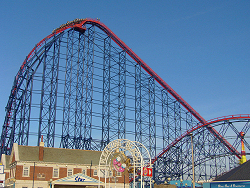 While we paced the floorboards, over the other side of the pond, Americans were breaking world records like it was going out of fashion. Cedar Point in Ohio has long made a habit of breaking records, and in 1989 it was the first park to breach the 200ft height record with Magnum XL-200.
While we paced the floorboards, over the other side of the pond, Americans were breaking world records like it was going out of fashion. Cedar Point in Ohio has long made a habit of breaking records, and in 1989 it was the first park to breach the 200ft height record with Magnum XL-200.
How we pined for such rides here on her majesty's shores here in old Blighty. As America left us for dust, we wondered whether we'd ever see such a record breaker here seeing that our tallest coaster then was Alton Towers' Thunder Looper.
In the UK, the parks that had the financial clout for such a front page roller coaster were confined by unforgiving planning restrictions, and as already one of the most compact parks in the world, it would have been easy to rule Blackpool Pleasure Beach out of the equation owing to the space available to them.
Somehow, tip-toeing around one of the most unforgiving and awkward construction sites in history, a deep blue mountain of steel slowly rose up from the Pleasure Beach, topped by a thread of red track using every opportunity to climb not only over Blackpool's historical rides, but in the case of the Big Dipper and Roller Coaster, through them.
Not only did the mile-long track have to tread carefully, but even the station had to adopt almost a cylindrical shape in order to fit above the park Monorail and the Pleasure Beach Express railway lines that run below this rotund building.
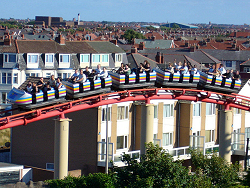 In 1994, amid much fanfare, the Pepsi Max Big One opened as the tallest, fastest and steepest roller coaster in the world.
In 1994, amid much fanfare, the Pepsi Max Big One opened as the tallest, fastest and steepest roller coaster in the world.
Since 1994, the record for the tallest coaster has led the life of a nomad and a veritable globetrotter. As well as calling in on his friends at Cedar Point (Millennium Force and Top Thrill Dragster), he has also called in at Japan (Steel Dragon 2000) and also on a European level with Europa Park's Silver Star, which supersedes the Big One as Europe's tallest roller coaster.
It is well documented that roller coasters play an important part in ones psyche. Much of the thrill and apprehension associated with roller coasters is actually psychological. Bearing this in mind, as the ride edges itself into your line of sight as you approach Blackpool from 15 miles away, the sight alone is enough to drive you barmy.
By day, the inky blue structure reaches high into the sky above Blackpool alongside the 500ft tall Blackpool Tower, whilst by night it is hard not to fall in love with the beautiful sight of the ride lighting up the night sky, delivering initial impact like no other British coaster can muster.
 Inside the park, the Big One completely envelopes the park, but forms an ever-present backdrop that easily blends into the background much like the sky. Every minute or so the ride reminds you of its presence as a train laden with people cartwheels through the sky, over your head before diving out of view. The Big One makes its presence known like no other.
Inside the park, the Big One completely envelopes the park, but forms an ever-present backdrop that easily blends into the background much like the sky. Every minute or so the ride reminds you of its presence as a train laden with people cartwheels through the sky, over your head before diving out of view. The Big One makes its presence known like no other.
Even considering the space restrictions, the layout of the station area is impeccable. The wooden barrel-like station has track wrapped around it in the form of the turn into a giant can of Pepsi (other soft drinks are available from the marketplace) with the lift hill disappearing skywards. The main finale is hardly candid, either, with the train exploding out of an underground tunnel into the final brake run.
Once you pass between the now-disused cylindrical cash kiosks, you climb a gradual ramp up to the station, squeeze through the turnstile into the station before you enter the first of three station-length switch back queues.
Whether accidental or deliberate, the way the first drop is framed in the window at the opposite end of the station is an absolutely sublime touch, with the inside of the wood panelled station whitewashed and lit brightly in white. At night, the station roof is trimmed with chaser lights which electrically dart from one end of the station roof to the other.
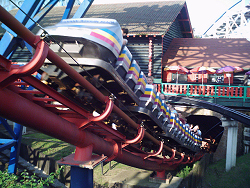 The platform isn't the largest in the world, and frankly isn't that accommodating to those who are picky about where they sit. With 200ft of height at its advantage, where you sit has great impact on the ride you'll have, but sadly you do not have the luxury of being too choosy.
The platform isn't the largest in the world, and frankly isn't that accommodating to those who are picky about where they sit. With 200ft of height at its advantage, where you sit has great impact on the ride you'll have, but sadly you do not have the luxury of being too choosy.
The trains are good looking with a sharp nose, fronted by two headlights, liveried in silver with red, amber and blue stripes running the length of the train. Each train is five cars long, each seating three pairs of riders secured with an individual lap bar and seatbelt each.
The trains aren't the best upholstered in the world. The bucket seats are not the most forgiving once the ride curls down a near-vertical corkscrew towards the Irish Sea, and the lap bars mean that not much space is afforded for you to shuffle sideways into your seat. As time has taken its toll on the fibreglass shell of the train, the floor is patched up with lumps of plyboard which as well as looking fairly unpresentable, does not represent the most comfortable surface to place your feet on.
As a wailing claxon sounds, the train rolls from the station, dipping sharply down and into a 180-degree bend sweeping around the base of the station into the centre of the oversized fizzy pop can.
Straight away, the train smoothly engages on the lift hill before it begins its first of many triumphant skyward climbs. I must admit, I love this lift hill for a number of reasons. The fact that it is 200ft tall goes a long way to help, and the obvious tension built upon this fact in the train is – even ten years on – quite immense. Furtherance to this, the view whereever you look is amazing. To the right, the Pleasure Beach mapped out below you, to your left, the Irish Sea coastline stretching away into the distance.
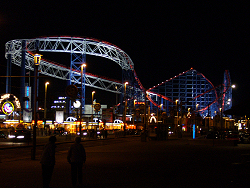 As you pass a forest of weathervanes and aircraft warning beacons at the top of this towering structure, the track warps out of view as the train curls downwards affording an amazing - if brief view of the promenade below before the train is quite literally wrenched to the right, curling around a precarious curve whilst it dives towards the roofs of the buildings below. As you reseat yourself after this fairly brash drop, you're soon climbing up a strangely flat hill parallel to the promenade before you sharply top out, dropping back down and following the front parade of shops and restaurants before sweeping to the right and climbing into the ride's main turnaround.
As you pass a forest of weathervanes and aircraft warning beacons at the top of this towering structure, the track warps out of view as the train curls downwards affording an amazing - if brief view of the promenade below before the train is quite literally wrenched to the right, curling around a precarious curve whilst it dives towards the roofs of the buildings below. As you reseat yourself after this fairly brash drop, you're soon climbing up a strangely flat hill parallel to the promenade before you sharply top out, dropping back down and following the front parade of shops and restaurants before sweeping to the right and climbing into the ride's main turnaround.
The train suddenly, and unnervingly tilts sharply to the right as it runs over the Grand National station, the plaza in front of it and the arcade below.
As the train regains an upright stance, you head towards the track entering the turn around, just about squeezing beneath the track offering the first of many head choppers as you head into the return leg of the ride.
As you climb another triangular hill in the shadow of the first hill out of the first drop, you drop down towards the Log Flume lake, pitching to the left as you do before climbing back out into another hill which is still cast in the shadows of the first hill before the coaster takes on an almost serpentine nature, pitching first to the left as it drops, bottoming out by pulling to the right and ducking underneath the lift structure.
Another climb sends the train once again banking to the left as it tops out, before heading towards the structure of the Big Dipper and then climbing up towards the mid-course brake-run.
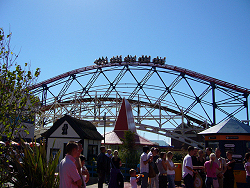 The front seat riders here will invariably get a healthy, although often painful bout of airtime as the train sharply straightens out for the brakes, and sadly the brakes make their unreserved presence known by taking a lot of the speed out of the train.
The front seat riders here will invariably get a healthy, although often painful bout of airtime as the train sharply straightens out for the brakes, and sadly the brakes make their unreserved presence known by taking a lot of the speed out of the train.
Then comes the helix which offers a strange sensation as the train slowly ambles around this undulating, banked track which runs over a scene from the Pleasure Beach Express before climbing up into another trademark triangular hill, dropping through the structure of the Roller Coaster before out of nowhere, the train curls into a sharp downward sweep, burrowing through a deep tunnel and then exploding out into daylight, heading skywards, careering out the way of the corner of the station roof just in time before the final brakes stop the train.
Even a decade on, the Big One is still regarded as one of the most famous and iconic roller coasters in Britain. It has featured on television, adverts and films, and still is a psychological challenge for the public to conquer.
How can a ride that has had such a lukewarm reception from enthusiasts exhibit so much staying power?
The ride is a one of a kind, not only nationally, but globally too. Say what you will about Arrow megacoasters and their triangular-topped hills and jerky transitions, but they offer a unique sensation, and one that is particularly befitting of the Pleasure Beach.
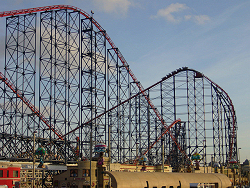 Furthermore, the setting of the Big One is absolutely note-perfect. There are few things with more mystique than a night time ride on the Big One, with the broody Irish Sea below, the promenade famously lit up with the Blackpool Illuminations and the Pleasure Beach twinkling away as if gold at the end of the rainbow.
Furthermore, the setting of the Big One is absolutely note-perfect. There are few things with more mystique than a night time ride on the Big One, with the broody Irish Sea below, the promenade famously lit up with the Blackpool Illuminations and the Pleasure Beach twinkling away as if gold at the end of the rainbow.
Ride-wise, the Big One is remarkable in places, whilst a lost opportunity in others.
The first drop has become famous the world over thanks to a 200ft corkscrewing 65-degree dive downwards at speeds approaching 75mph. Within the first few seasons, the first drop was re-modelled by Allot and Lomax meaning that the drop was cantilevered away from the main structure meaning it was smoother, faster and tighter. Also, the second highlight of the ride, the turnaround, was improved by making the turn tighter which in turn added to the effect of hanging off the side of the structure.
Elsewhere on the first half of the ride, there is little to make your jaws drop, but nevertheless, the sensation of speed wherever you sit in the train is pretty much unequalled within the UK.
The mid-course brake run completely destroys any pacing that the ride has up until that point rendering the following helix as a pointless intrusion before from nowhere the ride wakes up for an absolutely superb finale.
Whilst the ride lacks airtime, is jerky and ferocious, it is a perfectly complementing ride to the rest of Blackpool's line-up. If airtime is what you want, Blackpool has one of the best selections of powerful gravity defying rides elsewhere, so it seems futile to compete against them.
Whilst many people grieve for the unfulfilled potential of the Big One when comparing it against rides like Expedition Ge-Force, it's continued popularity further enforces the fact that despite it being dethroned by peoples' access to bigger and better rides, it very much has the fizz it did ten years ago.
Please, do not use our ratings to compare rides head-to-head. They rate only how well this ride meets its own objectives using criteria that may not necessarily be relevant with similar reviews.

Good points:
- Over a decade on, this ride is still iconic and one of the best-known coasters in the country
- Whatever you think of it, the public love the Big One
- Gives an amazing tour of the park ducking over and under existing rides and coasters
- Great views of Pleasure Beach Blackpool all the way along the Golden Mile
Bad points:
- Although not as rough as people make out, the Big One isn't the smoothest coaster ever
- Aside the first drop and perhaps the finale, the Big One's pacing leaves much to be desired
- The mid-course brakes almost stop the train
Labels: Coaster, PleasureBeachBlackpool, SandS